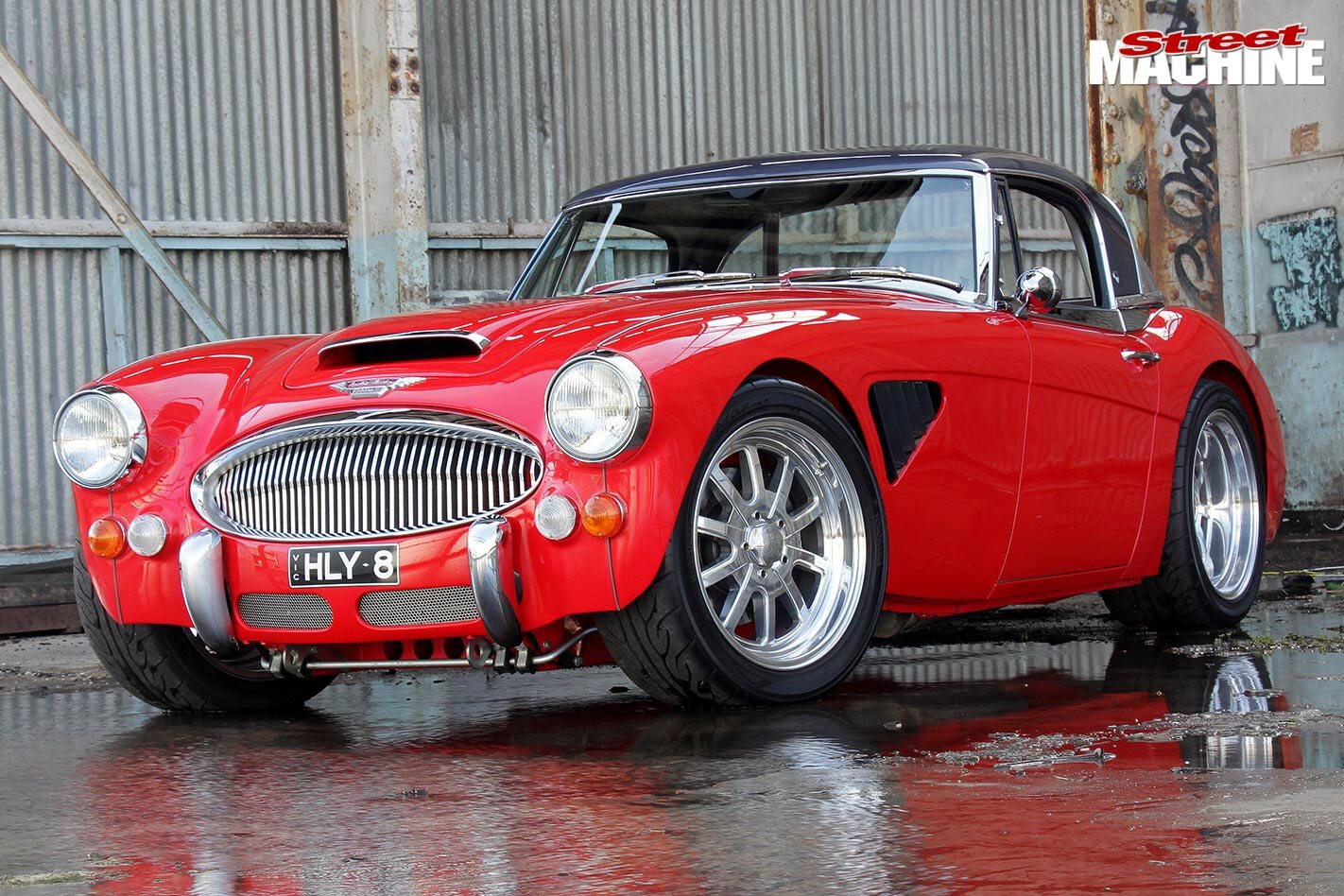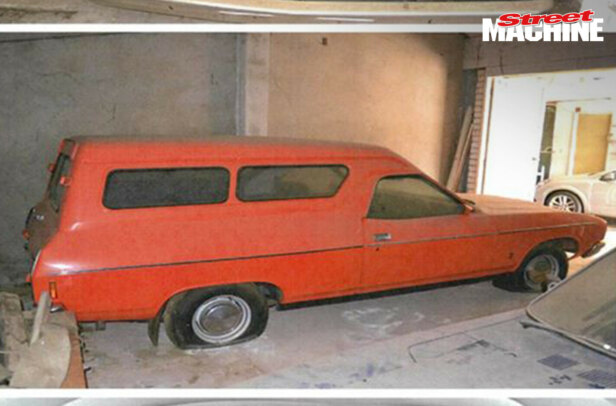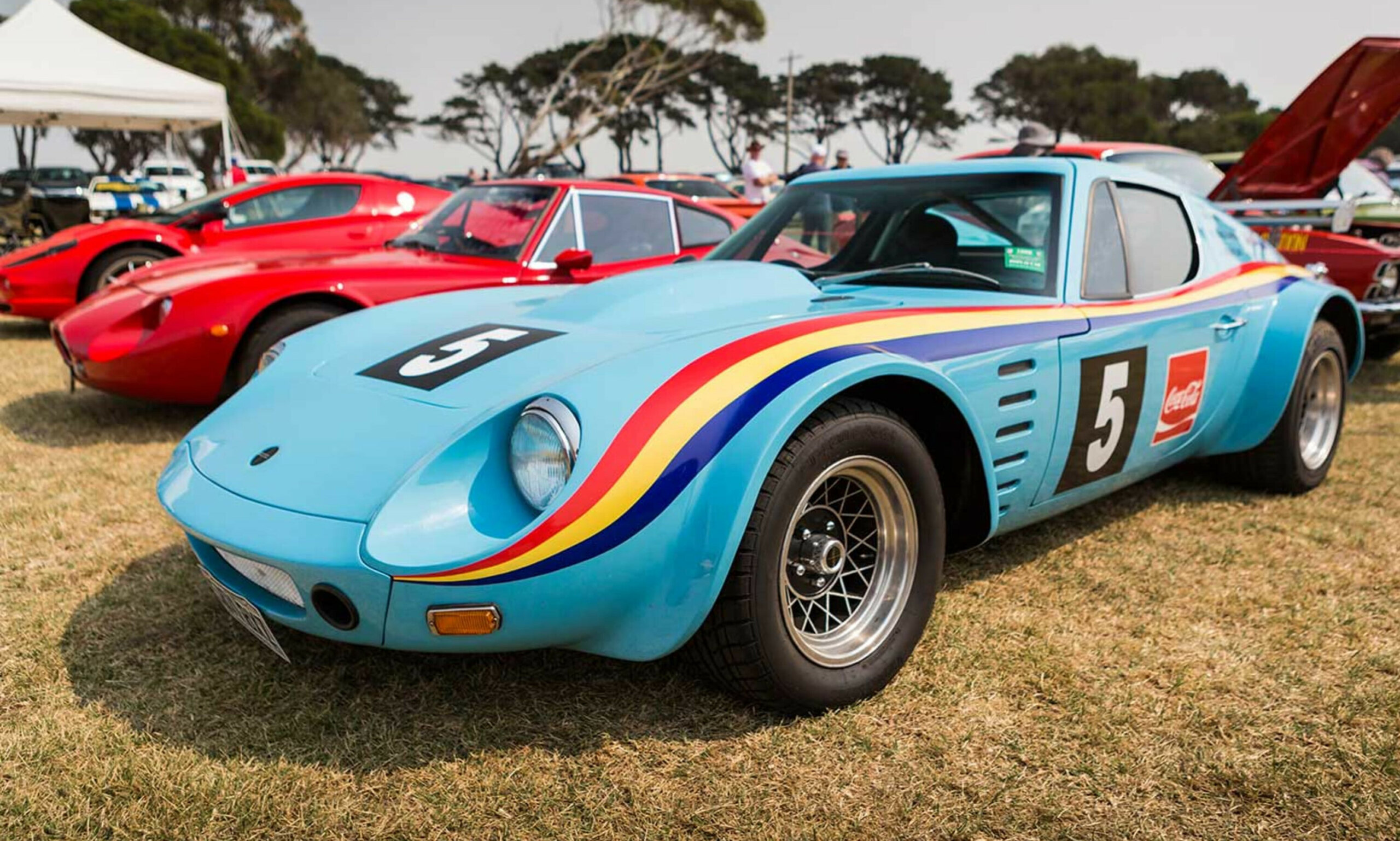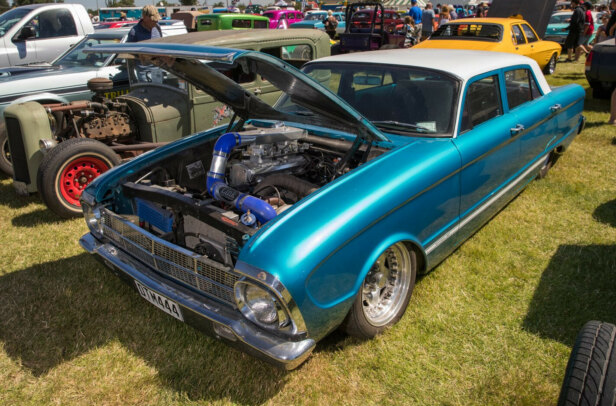This article on John Strick’s Healey was originally published in Street Machine’s LSX Tuner #8 magazine, 2018
JOHN Strick has built himself an anomaly; his Austin-Healey is not exactly a regular street machine, yet eschews the tropes found on traditional Healey builds. “Between you, me and the gatepost,” John starts, “the Healey purists hate it!
“Actually, hate is a strong word,” he continues, “it’s just that they don’t get the technology that’s gone into it.”
Conceding that John’s build has put some of the old boys’ noses out of joint is one thing, but the man then drops a bold statement.
“This isn’t the first V8 Healey ever built, but I wanted to do it better than anyone had done it before. The rest are chopped up to fit the V8. This was a fresh-air car.”
Plans for the world’s nastiest BJ8 Austin-Healey 3000 began while John still owned his previous carbied-and-cammed BJ7 ‘big Healey’.
“The standard Healeys were renowned for burning feet,” says John, “even when they were new.” Mindful of this, he custom-built a twin 2.5in exhaust that sits snug up inside the chassis and is fully ceramic-coated. The brand new Corvette C6 exhaust manifolds negate the need for extractors, having been ported by John to flow just as well. “They come with factory heat shielding, and besides, I needed them for packaging reasons. There are no heat issues; you can belt along for an hour at 100 miles per hour and the carpet is still cool”
“It was a hottie, but nothing like this,” he says. “This one took three years of planning, then seven years of building.”
While John handled the bulk of the work, he’s quick to admit he couldn’t have got it where it is today without the help of Greg Kilmartin. Kilmartin Automotive Sheetmetal has been creating replacement Healey parts for decades, with Greg’s surrogate chassis underpinning restorations worldwide.
But while the standard Kilmartin chassis is almost indistinguishable from the original item, John needed something bespoke for his project.
“Greg drew the whole concept in CAD from start to finish,” John says. “Every part under the skin is completely different to that of a standard Healey; not one part interchanges.”
With Kilmartin having all the jigging and tooling required to create something from nothing, John spent two years full-time in the corner of their workshop. Although he was keen for an entirely unique car, a donor was used for the basic exterior panels, windscreen surround and an important chassis member.
“I bought a one-owner car from Florida in the USA but it broke in half on the journey over here,” John laughs. “It was pretty stuffed.”
Knowing he’d install a monster 6.0-litre V8, John ditched the wobbly lever-arm front suspension, forever shifting the machine from proper British sports car to pro touring street machine.
“I took an old chassis down to McDonald Brothers Racing for them to chop up and prototype the new towers and tubular-arm suspension,” John explains. Although their regular fare revolves around Holden, Ford and Chrysler, thanks to John they can now offer you Healey suspension as well.
John installed the McDonald Brothers front end at Kilmartin, then designed a five-link rear end to put the power down. John spent so much time in the Kilmartin workshop that he forgot to leave once he trucked the Healey back home.
Rather than modify a steering rack, John installed a super-narrow item from a rare Subaru FF-1. “I spent a week with dial indicators, working on the front end to reduce bump-steer to nothing,” he says “The Healey steering column is about the most dangerous thing on earth. It starts 2in behind the grille and is a solid shaft all the way to about 2in from your chest!” A collapsible Triumph Spitfire steering column solved that, should it ever become an issue
“Greg had some work on, so I stayed on part-time for a couple of years helping out,” he says.
John’s a retired motor mechanic, but he’s also useful with a bunch of other tools, handling all the panelwork himself at home. While knocking a pile of 50-year-old scrap metal into shape, John contacted his local Holden dealer, which happened to have a GM-connected performance division.
“I ordered up new everything: L98 V8, Tremec T56 gearbox, flywheel, clutch, a/c pump, computer, wiring harness – every damned thing we needed to get that car to fire!” John says.
The gearbox was still strapped to its pallet when John shipped it to Mal Wood Automotive for an overhaul.
“The tolerances in these things aren’t great from new,” John explains. “Mal Wood also fitted a new Camaro extension housing, which brought the gearstick back to within an inch of the factory position.”
The workshop also fitted a short-shifter of their own design, which John reckons works nicer than the genuine GM item in his son’s Monaro.
The Austin-Healey 3000 runs BMC’s long 2912cc C-Series six-banger from the factory, so fitting the L98 V8 wasn’t too hard once John sorted out the custom front suspension.
“We only shifted the firewall back one inch,” he says. “However, if you want to drive a typical Healey you’ve got to be proportioned like a Tyrannosaurus Rex; all legs and no arms!” Addressing this, John moved the dashboard three inches further forward.
Chopping four inches out of the under-dash area became an issue when John started stuffing gear in there that no Healey was meant to have.
If you think whacking a whopper L98 LS donk into a 1200kg Healey has created a lead-tipped arrow, think again. The General’s 6.0L V8 and Tremec T56 six-speed manual together weigh 60kg less than the 3.0L Healey six and factory four-speed. The modified chassis is 20kg heavier than stock, so John has still come out in front
“The standard Healey had a heater the size of a matchbox; mine has a full Vintage Air system.”
John also found space for the ECU, comprehensive electronic instrumentation, eyeball vents, two-speed wipers, a stereo, a few speakers, and all the associated wiring.
“All the glovebox is good for is a pair of sunnies and a pen!” John laughs.
If those buckets look cosy, just try to make sure you’re about John’s size and shape; he hand-formed them to his precise specifications.
“They’re based on Healey 100S seats but are longer and deeper. I remember thinking I’d need something to hold me in well.”
Once the seats were ready for fabric, John activated Garry from Garry Blackman Trimming to cover them with Connolly leather, along with the door cards, dash top and custom centre console.
Between that fine interior, tickled-but-tidy L98, and incredible red paintjob by Garry ‘Grubby’ Watts, John has created a machine that transcends genre. As discussed, the Healey boys get a bit grumpy and the street machiners aren’t sure what to make of it.
Still, it matters not; it’s John’s car and he built it for John alone. He’s piled 13,000km on it, given it a retune, released more horses, and taken out a bunch of trophies since completion.
John handled all the bodywork, including prepping the car for paint. Old mate ‘Grubby’ Watts at Eureka Smash Repairs laid on the custom red and plenty of clear. Inside, everything is bespoke, despite looking like standard BJ8 Healey gear. “There are about four small parts that would be interchangeable,” says John. “I made all the dash, centre console and the seats and had Garry Blackman cover it all in Connolly leather.” As a proper sports car should be!
“I reckon it’s just the sweetest-looking thing on God’s earth,” says John. “But that’s just me, of course.”
And that’s all that matters, John.
HEAL BE RIGHT, MATE
BEING a collectible car from day dot, it’s pretty easy to find out the provenance of a Healey so long as you’ve got the chassis number. John’s Austin-Healey 3000 BJ8 was delivered brand new in July 1967 to St Louis, Missouri, resplendent in British Racing Green. It was one of the last 1000 Austin-Healey BJ8s built out of 17,712 total, and was one of just 38 with dealer-fitted air conditioning.
John designed the five-link, coil-over rear end, then had McDonald Brothers build him a stout rear supplied in a custom housing but devoid of bracketry. “I spent days mucking around with the rear end; travel, diff going this way, diff going that way,” John says. All the good gear is up there, including an Eaton Truetrac LSD and Strange 3.5 gears
John purchased it from the president of a Florida-based Healey club who had bought it from the grandson of the original owner. It wasn’t pretty; during the journey to Australia, it snapped in half, with the leaf springs breaking through the floor and spearing the seats, the arse jammed against the ground. John wasn’t too concerned, as he didn’t pay a lot for it at a time when the Aussie dollar was good against the greenback.
Since then, the value of ‘big Healeys’ has skyrocketed, leaving John to regret every modification and wishing he’d done a straight resto. Like hell!
JOHN STRICK
1967 AUSTIN-HEALEY ‘6000’ BJ8
PAINT
PPG special-mix red
ENGINE
Type: GM Gen IV L98
Capacity: 6.0-litre
Intake: Stock
ECU: Stock with custom tune
Injectors: Stock
Cam: COMP Cams
Pushrods: COMP Cams chrome-moly
Lifters: Stock
Valve springs: COMP Cams conical
Fuel pump: VE Commodore in-tank
Exhaust: Ported and polished C6 Corvette manifolds into high-flow catalytic converters, custom-built mufflers, ceramic-coated twin 2.5in exhaust
TRANSMISSION
Transmission: Tremec T56 with Camaro extension housing and Mal Wood Automotive short-shifter
Clutch: Stock
Diff: Strange 9in with 3.5:1 gears in McDonald Brothers Racing housing and billet axles
Tailshaft: Duggan Balancing special build
SUSPENSION & BRAKES
Springs: Viking Performance (f & r)
Shocks: QA1 coil-overs with adjustable rebound (f & r)
Chassis: Subaru FF-1 rack ’n’ pinion with Triumph column, McDonald Brothers Racing double wishbone front end, custom adjustable five-link rear
Brakes: PBR rotors, Ford XR8 calipers (f & r)
WHEELS & TYRES
Wheels: Dragway DB131 custom; 17×8 (f), 17×9 (r)
Rubber: Yokohama ADVAN Neova AD08R; 235/45 (f), 255/40 (r)




Comments